How to Feed & Maintain your Sourdough Starter
You’ve done it! You’ve created a living batter filled with wild yeast. Now let’s see how to feed & maintain your sourdough starter.
If you haven’t made your starter yet, visit this post to see how to make a sourdough starter from scratch.
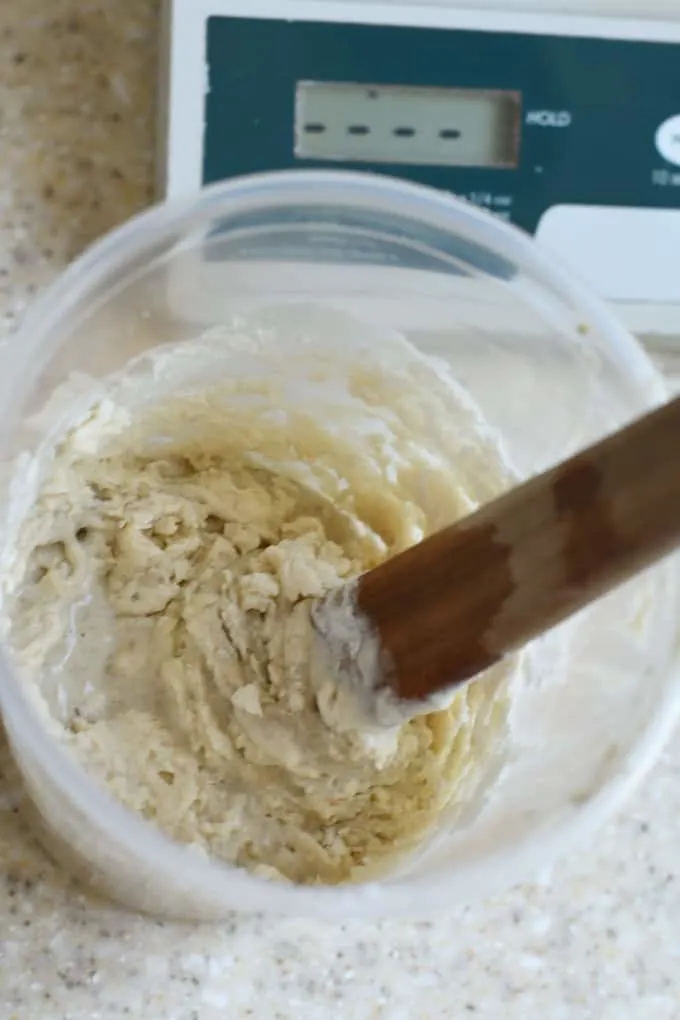
Right off the bat I’m going to say that there are a million ways to feed, maintain and use a sourdough starter. In fact, after you’re done reading this post, you should read through my instructions for How to keep a small sourdough starter to see of that method would work better for you.
I am going to outline for you how I maintain my sourdough starters. I tend to have a fairly relaxed attitude towards the process. It works for me and I think my approach can work for you if you don’t bake bread every single day (and even if you do).
At the end of the post you’ll find a how-to card that lists the ingredient amounts and steps to follow each time you feed your starter.
But first I’m going to give you all the how’s and why’s and try to answer any questions you might have.
Tips for using and maintaining your sourdough starter:
- Since I don’t bake every day, I keep my starters (yes, I have 3) in the refrigerator.
- If I’m making a 2-day recipe (most of mine are) I take the starter out of the refrigerator early in the morning of the day I’m making the dough. If the starter is inactive I feed it right away and it should be ready by early afternoon.
- If I’m making a 1-day recipe, I’ll take the starter out the night before and feed it if it’s inactive. It should be ready to use first thing in the morning.
- When the starter is cold from the refrigerator, I feed the starter using fairly warm water, warmer than body temp. The warm water will jump-start the cold starter.
- If the starter has been fed within the last 2-3 days, and has been refrigerated, you can probably go ahead and use it without feeding.
- If you’re not sure if the starter is active, drop a dollop into a bowl of water to see if it floats. If it does, it’s ready for baking.
- I write all my sourdough recipes to use 8 oz of active starter. After using 8 oz of starter in the recipe, I’m left with 4 oz of starter, exactly the right amount for feeding.
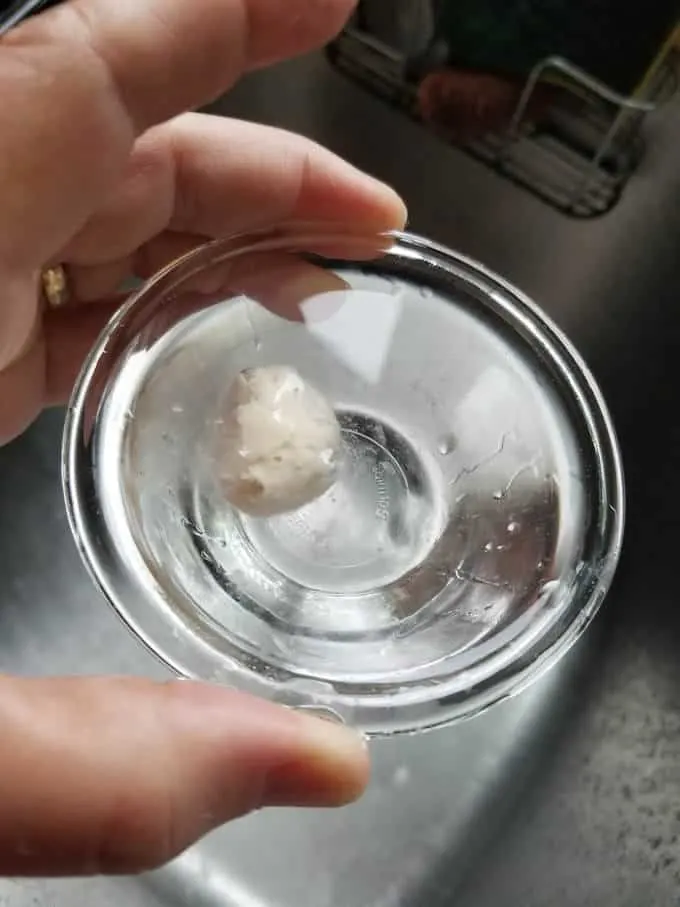
Schedule for feeding your sourdough starter:
- Your starter needs to be fed about 1x per week if refrigerated, and every day if left at room temperature.
- Generally, about 5-6 hours after feeding my starter is ready. The time may vary based on room temp, dough temp, etc. The starter should have doubled in volume and started to recede and/or pass the float test.
- I take my starter out of the refrigerator once a week for feeding, even if I’m not baking. Although, truth be told, I often go longer than a week between feedings and I haven’t killed it yet.
- Did you know you can dry your sourdough starter? Dried starter can be kept indefinitely.
- After you’ve removed the portion of starter for baking, feed the starter again and leave it at room temperature for 3-4 hours before putting it back in the refrigerator.
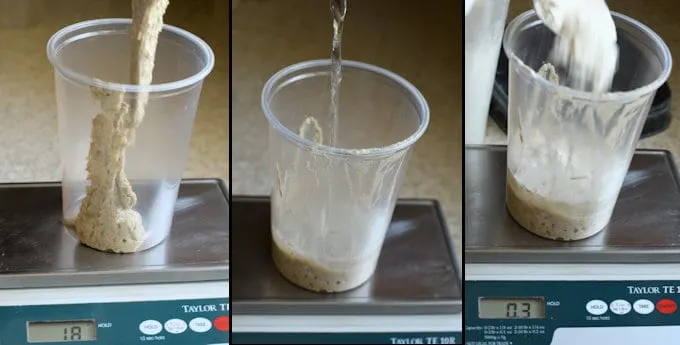
FAQs about feeding & maintaining Sourdough Starter:
Honestly, I’ve gone longer than a month without feeding my starter and I haven’t killed it yet. Give it a feeding and see if it wakes up. If it’s alive, keep feeding it until it is reliably doubling in size within 4-5 hours.
If you go more than about 2 weeks between feedings, you might want to give the starter 2-3 feedings before using. A starter that hasn’t been fed for weeks will be quite sluggish and your dough won’t be as lively.
If your starter was fed a day or two before, it’s possible to use the starter straight from the refrigerator. Give it a float test to make sure it’s active. The dough may take a little longer to ferment since the temperature of the dough will be colder.
It’s called “hooch” and don’t worry, your starter is still alive. Just stir that water back into the starter before feeding. Again, you might need 2 feedings to completely revive the starter since it’s been quite dormant.
To maintain your starter at 100% hydration it is best and most accurate to weigh your ingredients. If you’re just a little bit off every time you feed, eventually, your starter could be thrown out of balance.
No problem, use the amount of starter called for in the recipe. Then weigh out 4 oz of the remaining starter for feeding and discard the rest.
If you continually feed the starter without discarding, you’ll end up drowning in starter.
Yes, even if the discard is not active enough for baking bread, you can add it to many other recipes as a flavor and texture enhancer.
Unless you’re going away for an extended time, your starter should be just fine for a couple of weeks in the refrigerator. If you’ll be gone really long-term, put the starter into the freezer or dry it. Frozen or dried starter will need several feedings to rejuvenate.
If you appreciate this detailed information, I’d really appreciate a 5-star review.
How to Feed Sourdough Starter
Ingredients
- 4 oz unfed sourdough starter
- 4 oz all purpose flour
- 4 oz water (room temperature)
Instructions
- Weigh 4 oz of your unfed starter into a clean container. Discard the extra starter (see note)4 oz unfed sourdough starter
- Add the flour and water and mix until combined. Set aside at room temperature.4 oz all purpose flour, 4 oz water
- The starter is ready to use when it has doubled in volume and a small spoonful floats when dropped into a bowl of water. This generally takes 4-5 hours but the time can vary based on dough temperature and room temperature.
- If you do not plan to bake with the starter on the day it is fed, refrigerate 3-4 hours after feeding.
- Feed refrigerated starter weekly. If you go longer than a week without feeding, you may want to give the starter two feedings before using.
Would you like to save this recipe?
As an Amazon Associate and member of other affiliate programs, I earn from qualifying purchases.

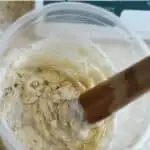





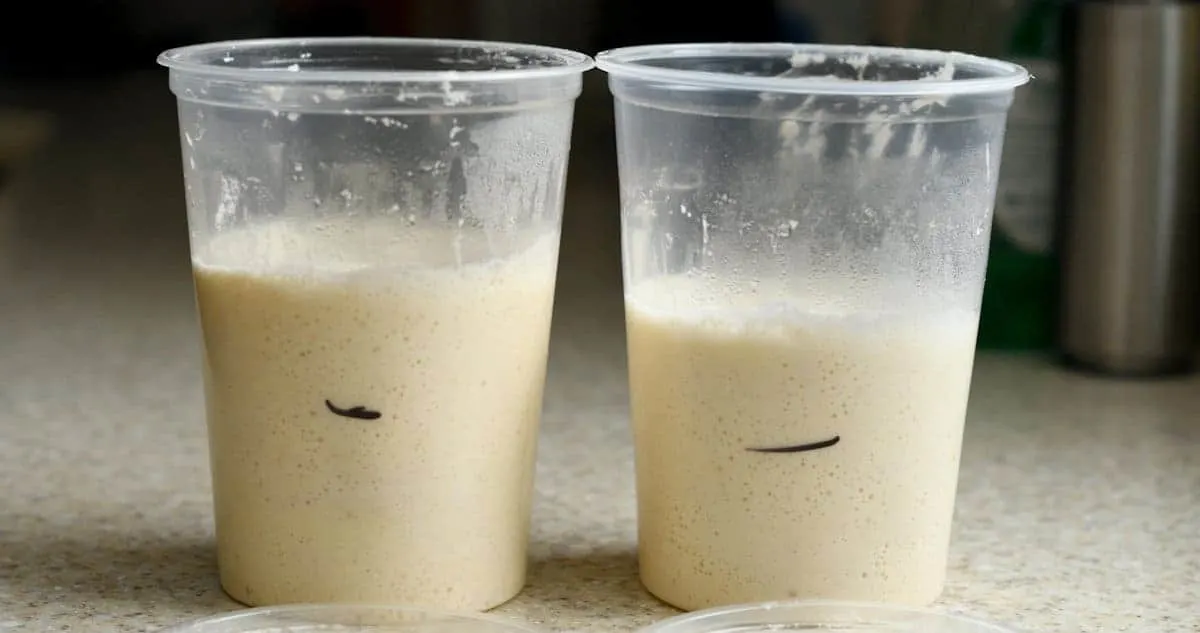
Hi,
Yesterday I decided to make a starter. I followed a recipe (not this one) and it told me that after I made it I should leave it out for the night. when I woke up this morning to check on my starter, I found that was bready on the top and the rest was an amber liquid. I stirred it all in and refrigerated it, and it looks fine. But recently a clear liquid developed on the surface. I just took it out of the fridge and placed it on the counter and I was wondering what you would recommend I do with it. Should I feed it or is it too early for that? Thanks.
Are you just beginning to make your starter? While you’re growing the starter it should not be refrigerated. You can read through my method for creating a sourdough starter to see photos of the various stages.
Hi!
A little late on the ball, but I’ll give it a try. If you intend to keep the sourdough starter in the fridge and feed it once a week, and for this example, not intend to bake it. Do you stil use warm water when feeding it? Do you put it right back in after feeding or keep it at room temperature for a while?
The reason for the feeding is to give the yeast some food to keep it alive. The yeast is more active at warmer (not too warm) temp. Use warm water to activate the yeast and leave it at room temperature for a couple of hours to give it time to multiply and grow. Then it can go back in the fridge.
When you are ready to refrigerate your starter in the glass quart jar, do you screw the lid on or do you leave it loose?
Once the starter is active and ready to go in the refrigerator I use a tight fitting lid.
@Eileen Gray, I have been setting the lid on but not screwing it down with the ring, it seems to be ok. I love how you answer every ones questions so well. I have lots of ? haha I’m just getting started to the sour dough world. thank you
Hello
I just started making sourdough bread in March when I couldn’t find yeast. I make 6 loaves of bread twice a week. I use 3 cups of starter for a batch of 6 loaves. So I never discard any starter. After I make the dough, I feed the starter a couple of times and put it in the refrigerator. I take it out in a couple of days when I make bread again. I usually use it right out of the refrigerator without feeding it. I don’t really measure when I feed the started I add about 3/4 cup of flour and then enough water to make it like a pretty thick pancaker batter. Is this OK. Will the starter go bad or get really strong if I don’t discard any? This has been working for about 6 months and I’ve started selling some bread at a farmers market. I just don’t want to ruin my starter. Thanks
If it ain’t broke, don’t fix it! I have found that if I refrigerate my starter and then take it out within a day or two it is still good to use without feeding. The refrigerator slows down the fermentation. You may be pretty consistent if you have a good eye for how the starter should look when you feed it without measuring. But, personally, I would weigh the ingredients to be sure the starter is consistent, especially if you are selling your product. For selling, consistency is key.
I really enjoy your website, in particular your sourdough recipes. I started my sourdough journey in June and have now reached a level of comfort with my bread making and maintaining my starter. I have begun to experiment and have since made your soft white sandwich loaf and donuts. Your recipes are quite user friendly. Will continue to experiment with your other recipes. Thanks a mil.
You are quite welcome. Glad you having fun with sourdough. It’s endlessly fascinating.